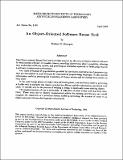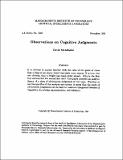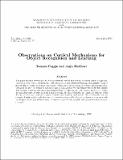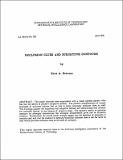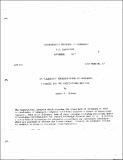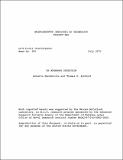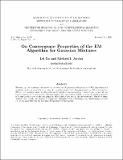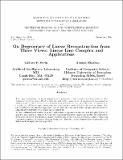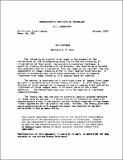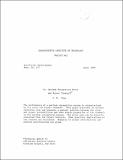Browsing AI Memos (1959 - 2004) by Title
Now showing items 704-723 of 1217
-
Object Detection in Images by Components
(1999-08-11)In this paper we present a component based person detection system that is capable of detecting frontal, rear and near side views of people, and partially occluded persons in cluttered scenes. The framework that is ... -
Object Recognition By Alignment Using Invariant Projections of Planar Surfaces
(1994-02-01)In order to recognize an object in an image, we must determine the best transformation from object model to the image. In this paper, we show that for features from coplanar surfaces which undergo linear transformations ... -
An Object-Oriented Software Reuse Tool
(1989-04-01)The Object-oriented Reuse Tool (ORT) supports the reuse of object-oriented software by maintaining a library of reusable classes and recording information about their reusability as well as information associated with their ... -
Observations on Cognitive Judgments
(1991-12-01)It is obvious to anyone familiar with the rules of the game of chess that a king on an empty board can reach every square. It is true, but not obvious, that a knight can reach every square. Why is the first fact obvious ... -
Observations on Cortical Mechanisms for Object Recognition andsLearning
(1993-12-01)This paper sketches a hypothetical cortical architecture for visual 3D object recognition based on a recent computational model. The view-centered scheme relies on modules for learning from examples, such as Hyperbf-like ... -
Obviously Synchronizable Series Expression: Part I: User's Manual for the OSS Macro Package
(1988-03-01)The benefits of programming in a functional style are well known. In particular, algorithms that are expressed as compositions of functions operating on series/vectors/streams of data elements are much easier to ... -
Obviously Synchronizable Series Expressions: Part I: User's Manual for the OSS Macro Package
(1987-10-01)The benefits of programming in a functional style are well known. In particular, algorithms that are expressed as compositions of functions operating on series/vectors/streams of data elements are much easier to ... -
Obviously Synchronizable Series Expressions: Part II: Overview of the Theory and Implementation
(1988-03-01)The benefits of programming in a functional style are well known. In particular, algorithms that are expressed as compositions of functions operating on series/vectors/streams of data elements are much easier to ... -
Occlusion Clues and Subjective Contours
(1976-06-01)The paper describes some experiments with a visual agnosia patient who has lost the abillity to perceive subjective contours. The patient's interpretations of simple examples of occlusion indicate that he fails to ... -
Offices are Open Systems
(1987-02-01)This paper takes a prescriptive stance on how to establish the information-processing foundations for taking action and making decisions in office work from an open system perspective. We propose due process as a ... -
Olympic Robot Building Manual
(1988-12-01)The 1989 AI Lab Winter Olympics will take a slightly different twist from previous Olympiads. Although there will still be a dozen or so athletic competitions, the annual talent show finale will now be a display not ... -
On "Learnable" Representations of Knowledge: A Meaning for the Computational Metaphor
(1977-09-01)The computational metaphor which proposes the comparison of processes of mind to realizable or imaginable computer activities suggests a number of educational concerns. This paper discusses some of those concerns ... -
On Boundary Detection
(1970-07-01)A description is given of how edge erase of prismatic objects appear through a television camera serving as visual input to a computer. Two types of edge-finding predicates are proposed and compared, one linear in intensity, ... -
On Convergence Properties of the EM Algorithm for Gaussian Mixtures
(1995-04-21)"Expectation-Maximization'' (EM) algorithm and gradient-based approaches for maximum likelihood learning of finite Gaussian mixtures. We show that the EM step in parameter space is obtained from the gradient via a ... -
On Degeneracy of Linear Reconstruction from Three Views: Linear Line Complex and Applications
(1997-12-01)This paper investigates the linear degeneracies of projective structure estimation from point and line features across three views. We show that the rank of the linear system of equations for recovering the trilinear tensor ... -
On Dynamic Models of Robot Force Control
(1986-07-01)For precise robot control, endpoint compliance strategies utilize feedback from a force sensor located near the tool/workpiece interface. Such endpoint force control systems have been observed in the laboratory to be ... -
On Edge Detection
(1984-08-01)Edge detection is the process that attempts to characterize the intensity changes in the image in terms of the physical processes that have originated them. A critical, intermediate goal of edge detection is the detection ... -
On Lightness
(1973-10-01)The intensity at a point in an image is the product of the reflectance at the corresponding object point and the intensity of illumination at that point. We are able to perceive lightness, a quantity closely correlated ... -
On Multiple Moving Objects
(1986-05-01)This paper explores the motion planning problem for multiple moving objects. The approach taken consists of assigning priorities to the objects, then planning motions one object at a time. For each moving object, the ... -
On Optimum Recognition Error and Reject Tradeoff
(1969-04-01)The performance of a pattern recognition system is characterized by its error and reject tradeoff. This paper describes an optimum rejection rule and presents a general relation between the error and reject probabilities ...



